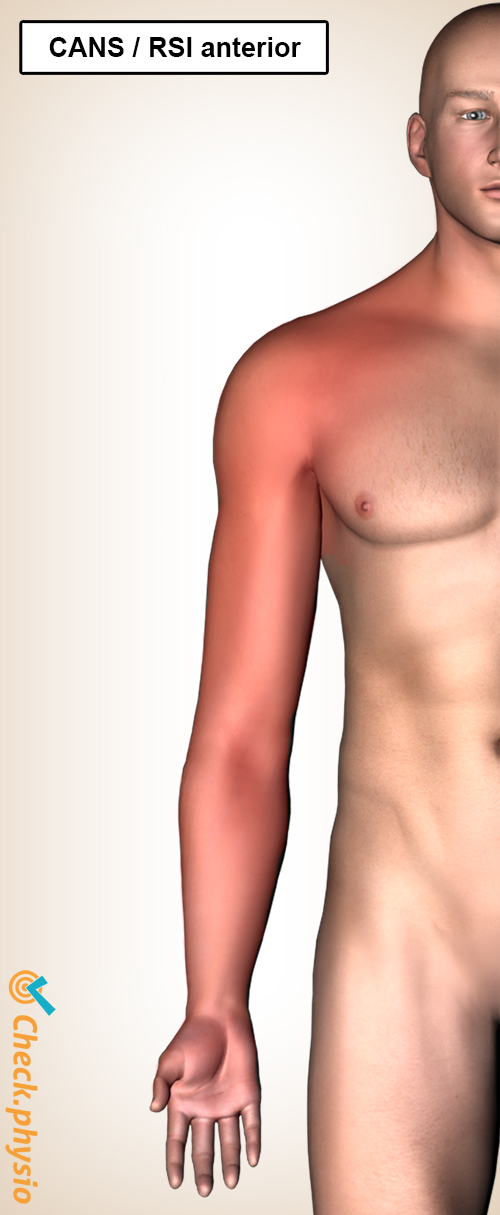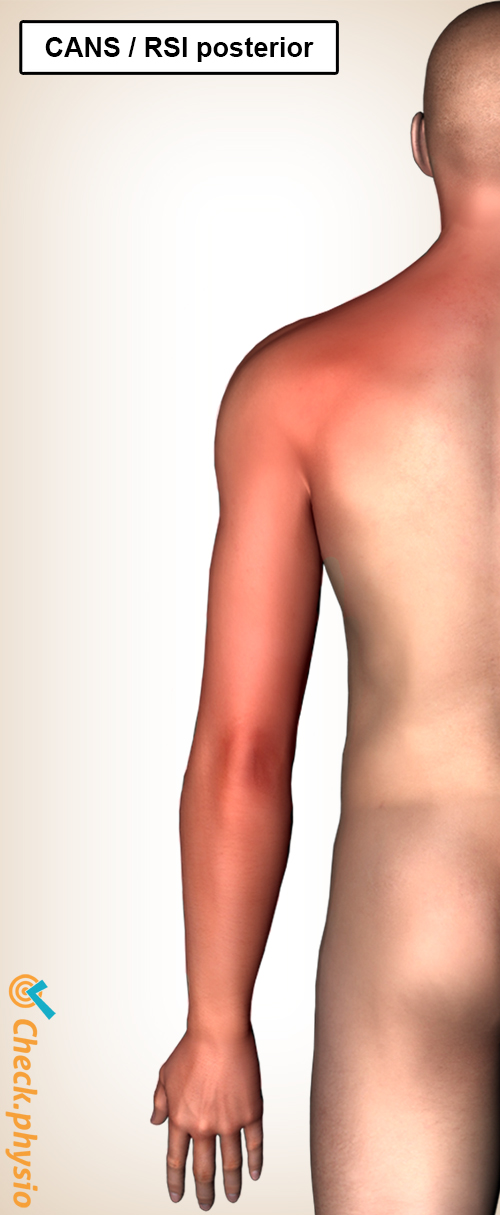- Conditions
- CANS (complaints of arm, neck and/or shoulder)
CANS (complaints of arm, neck and/or shoulder) RSI / CANS / Mouse arm
Introduction
CANS is a collective term for 'complaints of the arm, neck and/or shoulder'. This general term is used for complaints that can cause pain, stiffness, loss of strength and/or tingling in the area from the neck to the hand.
CANS is often regarded as a work-related problem, but this is not necessarily the case. Complaints can also develop at home or on the sports field. These are known in the vernacular as mouse arm, tablet neck, smartphone wrist, Gameboy thumb or WhatsApp thumb.

Description of the condition
CANS is the new name for complaints that we used to call RSI. RSI stands for repetitive strain injury. The name suggests that the complaints are always the result of frequently performing a certain activity or movement. Since this is by no means always the case, the term RSI has been replaced by the more common name CANS (complaints of the arm, neck and/or shoulder).
Approximately one in four employees have been found to suffer, to a greater or lesser extent, from physical complaints associated with CANS. CANS complaints have an insidious onset and gradually get worse if nothing is done about the cause. These complaints can lead to serious limitations in both work and private life.
CANS can be categorised into specific and non-specific complaints. Some specific complaints are, for example, tennis elbow, golfer’s elbow, thoracic outlet syndrome (TOS) or tendonitis. When no clear diagnosis can be made, the complaints
are non-specific.
Cause and origin
CANS is generally caused by frequently (possibly forcefully) performing the same actions with the arm. However, CANS can also occur if someone spends a long time in the same position, which causes excessive strain on the arm, neck or shoulders. Some examples of this are: sitting at the computer for a long time while maintaining an incorrect posture, assembly line work, painting, sports, etc. Therefore, these complaints do not develop due to an accident in which someone injures the arm, neck or shoulder.
Classification of risk factors
Many factors are known to increase the risk of CANS. These are divided into three categories:
Category 1
The first category includes personal factors such as the female gender and poor physical health.
Category 2
The second category contains environmental factors at home. This may include a poorly designed workplace, high workload or an irritating boss or, as the case may be, colleagues.
Category 3
Then there are activity-related factors that make up the third category. These are actions that have to be performed and the lack of variety therein.
CANS is actually always based on a combination of multiple factors mentioned above.
Signs & symptoms
Because CANS is a very general term, the symptoms can also vary greatly.
The most common symptoms are:
- Pain and/or stiffness in the neck, shoulders, arm or hand.
- Loss of strength.
- Tingling.
Other characteristics include:
- Symptoms develop gradually and get progressively worse.
- Symptoms are aggravated by tension, activity or stress.
- Symptoms are aggravated when a posture is maintained for a long time or when certain movements are repeated over and over again.
Diagnosis
A doctor or physiotherapist will ask about the complaints and how they developed. If the complaints developed as a result of an accident or a fall, CANS is ruled out in the first place.
During the physical examination, it will be determined whether specific CANS or non-specific CANS is involved. The posture, muscle tension and mobility of the joints will be assessed. Generally, additional testing is not necessary in the event of these complaints.
Treatment and recovery
It is important to act quickly at the onset of symptoms in order to prevent aggravation. The relationship between strain (what is required from the body) and capacity (what the body can handle) must be restored.
If the cause of the symptoms is not removed, the symptoms will not disappear either. Together with a physiotherapist, it is possible to examine which risk factors cause and/or maintain the symptoms.
The way in which the symptoms are dealt with is very important. The treatment will focus on (working) posture, mobility of the joints and physical condition. Although it can sometimes take a long time, recovery from CANS is generally quite possible.
Exercises
Follow the exercise programme with exercises for CANS.
More info
You can check your symptoms using the online physiotherapy check or make an appointment with a physiotherapy practice in your area.
References
Heemskerk, M.A.M.B., Staal, J.B., Bierma-Zeinstra, S.M.A., Haan, G. de, Hagenaars, L.H.A., Lanser, K., Windt, D.A.W.M. van der, Oostendorp, R.A.B. & Hendriks, H.J.M. (2010) KNGF-richtlijn. Klachten aan de arm, nek en/of schouder (KANS) Jaargang 120. Nummer 1.

